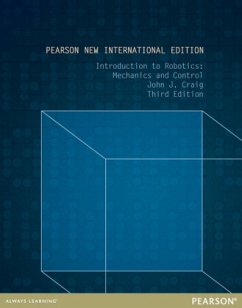For senior-year or first-year graduate level robotics courses generally taught from the mechanical engineering, electrical engineering, or computer science departments. Since its original publication in 1986, Craig's Introduction to Robotics: Mechanics and Control has been the market’s leading textbook used for teaching robotics at the university level. With perhaps one-half of the material from traditional mechanical engineering material, one-fourth control theoretical material, and one-fourth computer science, it covers rigid-body transformations, forward and inverse positional kinematics, velocities and Jacobians of linkages, dynamics, linear control, non-linear control, force control methodologies, mechanical design aspects, and programming of robots.
Features + Benefits
NEW - Chapter 1: Introduction has been enhanced to broaden the introductory presentation of the field of robotics—Previews what is covered in the book.
Develops students' interest early in the book.
NEW - Clear exposition.
Presents students with a good reference for background coverage of material.
NEW - Includes MATLAB exercises.
Real-world practicality with underlying theory presented.
Teaches students how to actually write algorithms to perform required computations.
Large set of homework problems with a “difficulty grade” assigned.
Allows instructors to easily implement a grade-point plan.
The most cited textbook on robotics in the field.
Provides students with the familiarity of the “classic text” on robotics.
“Programming Assignments” at the end of each chapter.
Makes it easier for the instructor to emphasize the software side.
1. Introduction.
2. Spatial Transformations.
3. Forward Kinematics.
4. Inverse Kinematics.
5. Velocities, Static Forces, and Jacobians.
6. Dynamics.
7. Trajectory Planning.
8. Mechanical Design of Robots.
9. Linear Control.
10. Non-Linear Control.
11. Force Control.
12. Programming Languages and Systems.
13. Simulation and Off-Line Programming.
Features + Benefits
NEW - Chapter 1: Introduction has been enhanced to broaden the introductory presentation of the field of robotics—Previews what is covered in the book.
Develops students' interest early in the book.
NEW - Clear exposition.
Presents students with a good reference for background coverage of material.
NEW - Includes MATLAB exercises.
Real-world practicality with underlying theory presented.
Teaches students how to actually write algorithms to perform required computations.
Large set of homework problems with a “difficulty grade” assigned.
Allows instructors to easily implement a grade-point plan.
The most cited textbook on robotics in the field.
Provides students with the familiarity of the “classic text” on robotics.
“Programming Assignments” at the end of each chapter.
Makes it easier for the instructor to emphasize the software side.
1. Introduction.
2. Spatial Transformations.
3. Forward Kinematics.
4. Inverse Kinematics.
5. Velocities, Static Forces, and Jacobians.
6. Dynamics.
7. Trajectory Planning.
8. Mechanical Design of Robots.
9. Linear Control.
10. Non-Linear Control.
11. Force Control.
12. Programming Languages and Systems.
13. Simulation and Off-Line Programming.

